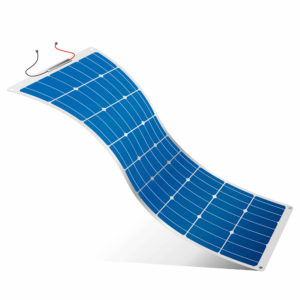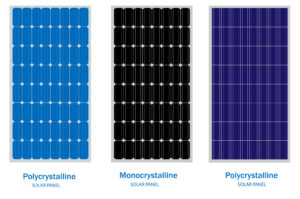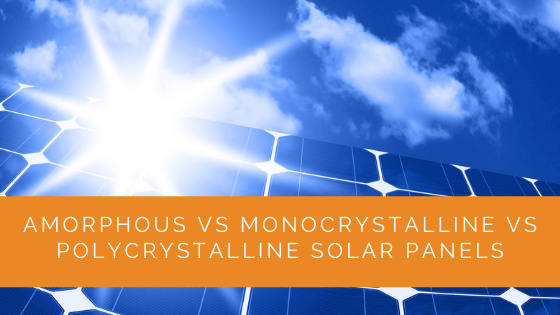Summer arrives in the United States even before you realize it, and along with it come higher energy expenses. Choosing the right kind of solar panel type can enable you to ensure more efficiency at a lower cost!
Installing a solar panel is an excellent way to save money on electricity, minimize environmental effects, and benefit from a variety of additional advantages, such as promoting local companies and economizing energy.
There are mainly three solar panels types: amorphous, polycrystalline, and monocrystalline panels. Each of them differs in its specifications, efficiency, and performance. This article will help you distinguish among the three and make the appropriate investment decisions. Let’s get straight into the article and find out more!
Contents
- 1 Key Takeaways
- 2 Working of the Solar Panels
- 3 Economical Viability
- 4 Flexibility and Ease of Installation
- 5 Efficient Performance
- 6 Weight and Transportation
- 7 Aesthetically Pleasing
- 8 Tolerance to Shade
- 9 Strength and Durability
- 10 Tolerance for Extreme Weather Conditions
- 11 Benefits of Investing In Any Solar Panel
- 12 Case Study: Evaluating the Best Solar Panel Type for Residential Use
- 13 Expert Insights From Our Solar Panel Installers About Amorphous Vs Monocrystalline Vs Polycrystalline Solar Panels
- 14 Experience Solar Excellence with Us!
- 15 Bottom Line
Key Takeaways
- Amorphous solar panels are the most cost-effective option, making them suitable for those on a budget.
- Amorphous panels are the best choice when flexibility is essential, as they are lightweight and easy to install.
- Monocrystalline and polycrystalline panels outperform amorphous panels in terms of efficiency, with monocrystalline being the most efficient among them.
Working of the Solar Panels
Amorphous solar panels, unlike polycrystalline and monocrystalline panels, are not split into solar cells. Instead, photovoltaic layers cover the whole surface. It is also known as a “thin-film solar panel.”
A monocrystalline solar panel is one that is composed of a single silicon solar cell. The Czochralski process is used to make these types of cells. They are also called “mono solar panels.”
Each PV cell in a polycrystalline panel is constructed from several silicon crystal pieces that are fused together in the course of the production process. They are sometimes referred to as “multi-crystalline panels.”
Economical Viability
Amorphous solar panels are the least costly of the three, followed by polycrystalline panels and monocrystalline solar panels.
Local labor expenses also influence the cost of a residential solar system. Moreover, remember that the total price of solar installation will include units such as the power inverter, racking, cabling, and breakers.
Thus, If you are looking for a cheap yet effective solar panel, opt for amorphous solar panels.
Flexibility and Ease of Installation
Flexible solar panels need less effort to install and are far more portable and easier to manage than rigid panels, which may be large in size, heavy, and involve extensive roof mounting solutions.
Amorphous cells are made of a thin silicon surface, allowing solar panels to become more flexible. In contrast, monocrystalline and polycrystalline panels are rigid.
Therefore, amorphous panels are the best option when flexibility is the criterion.

Efficient Performance
Solar panels’ efficiency and power output are inextricably linked because more efficiency implies more power with the available solar radiation. However, the size of solar panels must also be considered since a larger panel has a greater surface area to capture sunlight.
If you compare similar-sized solar panels, you may obtain the following ranking in terms of efficiency:
- Monocrystalline solar panels: High efficiency, often greater than 19%
- Polycrystalline solar panels: moderate efficiency of 15-17%
- Amorphous solar panels: Lowest efficiency, often less than 15%
Therefore, monocrystalline and polycrystalline panels are more efficient than amorphous panels.
Weight and Transportation
It’s critical to consider the weight of rooftop solar panels before installing them, as they might affect the roof’s structural stability. Solar panels are expected to be installed on top of the roof for an extended length of time. Therefore, prior to installing it, make sure of the panel weight.
Amorphous or thin-film panels are the lightest solar panels compared to others due to their thin-film technology. They are highly flexible and lightweight, making them easier to transport and install.
Monocrystalline and polycrystalline panels are comparatively heavier and less feasible.
Aesthetically Pleasing
The color and amount of cells in a solar panel can be used to define its appearance.
Most monocrystalline panels contain black-colored 60 to 72 silicon monocrystalline cells with clipped corners. Whereas blue cells having sharp edges make up polycrystalline panels. They usually come in 60 or 72 cell configurations, just as mono panels.
Instead of discrete solar cells, thin-film solar panels feature a homogeneous surface containing layers of photovoltaic material. Amorphous panels use thin-film technology and come in a variety of colors, including black, grey, and even blue, depending on the material properties.
Tolerance to Shade
Solar panels perform optimally when no shadow is thrown on them. A shade cast on a portion of a unit in a solar power system might jeopardize the entire system’s performance.
Since amorphous thin film performs best in low light conditions, it outperforms even the most efficient monocrystalline panels in less than perfect sunshine conditions. Due to its ability to absorb a more extensive range of visible spectrum of light, certain specific variants of the amorphous material may utilize indoor light sources for electricity.
As a result, amorphous solar panels are more shade tolerant than other solar panels.

Strength and Durability
As your solar panels will be vulnerable to the outdoors, durability is also an important consideration. Panels that are prone to breaking should be avoided because failure in the system will burn a hole in your pocket.
Amorphous solar panels are more tolerant of faults than crystalline silicon, it lasts significantly longer, and damages don’t impact overall power production.
In contrast, polycrystalline solar panels and monocrystalline solar panels are far more fragile, and if any portion breaks, the whole system collapses.
Tolerance for Extreme Weather Conditions
The degree to which your solar cells work is among the most critical elements affecting the quantity of power they produce. It’s simple to assume that more sunlight, and hence more heat, equals more power, but this isn’t the case. Diverse solar panels respond in different ways to the operational temperature, but in every instance, a solar panel’s performance falls as the temperature rises.
Amorphous cells can sustain greater temperatures without compromising output when opposed to monocrystalline solar cells and polycrystalline solar cells.
The temperature coefficient Pmax of mono and poly cells is between -0.45 and -0.50 per cent. Thin-film panels made of amorphous materials have a rating of -0.20 per cent to -0.25 per cent.
Benefits of Investing In Any Solar Panel
Solar energy is a kind of renewable energy that is not depleted over time. According to research, by 2030, more than one in every seven households in the United States will have a rooftop solar PV system. The following are some of the advantages of using solar power:
- It is a clean source of energy that promotes long-term growth.
- It ensures a steady supply of power while lowering electricity expenses.
- There is no loss of electricity.
- It is a source of energy that is relatively inexpensive.
As a result, solar technology is a cost-effective and reliable source of energy.
Case Study: Evaluating the Best Solar Panel Type for Residential Use
Background
Solar Panels Network USA was approached by a homeowner looking to install a solar energy system. To make an informed decision, the client wanted to understand the differences between amorphous, monocrystalline, and polycrystalline solar panels. Our goal was to provide a detailed comparison and recommend the best option based on the client’s needs, budget, and roof space.
Project Overview
The project involved a comprehensive assessment of the client’s property, energy needs, and budget. We aimed to evaluate the three types of solar panels—amorphous, monocrystalline, and polycrystalline—and provide a balanced cost, efficiency, and performance recommendation.
Implementation
Initial Assessment and Requirements Analysis
We began by assessing the client’s property, including roof space, orientation, and sunlight exposure. The client provided their energy consumption data, allowing us to estimate the required system size. We also discussed their budget and aesthetic preferences.
Comparative Analysis of Solar Panels
- Amorphous Solar Panels: Known for their flexibility and lightweight design, amorphous panels are the most cost-effective option. They perform well in low-light conditions but have the lowest efficiency, typically less than 15%. These panels are suitable for projects where budget and flexibility are primary concerns.
- Monocrystalline Solar Panels: These panels offer the highest efficiency, often exceeding 19%. They are ideal for maximizing energy production in limited roof space. Monocrystalline panels are more expensive but provide superior performance and durability, making them a long-term investment.
- Polycrystalline Solar Panels: With a moderate efficiency of 15-17%, polycrystalline panels offer a balance between cost and performance. They are a practical choice for homeowners with ample roof space and a mid-range budget. Although they are less efficient than monocrystalline panels, they are more affordable and still provide reliable energy output.
Recommendation and Justification
Based on the client’s requirements, we recommended monocrystalline solar panels. Although they were the most expensive option, their high efficiency and superior performance justified the investment. The client’s limited roof space and desire for maximum energy production made monocrystalline panels the ideal choice.
Results
The installation of monocrystalline solar panels resulted in optimal energy production, effectively meeting the client’s energy needs. The panels’ high efficiency maximized the use of available roof space, ensuring the system’s performance and long-term reliability. The client was highly satisfied with the decision, appreciating the balance of cost and benefits.
Summary
Selecting the right type of solar panel is crucial for maximizing energy production and return on investment. This case study highlights how a thorough assessment of needs, budget, and property specifics can guide the decision-making process. At Solar Panels Network USA, our expertise ensures that clients receive tailored recommendations, helping them choose the best solar solution for their homes. By considering factors like efficiency, cost, and flexibility, we provide reliable and efficient energy solutions that support sustainable living.
Expert Insights From Our Solar Panel Installers About Amorphous Vs Monocrystalline Vs Polycrystalline Solar Panels
Choosing the right type of solar panel depends on your specific needs. Amorphous panels are great for flexibility and budget-friendliness, while monocrystalline panels offer the highest efficiency, ideal for limited roof space.
Lead Solar Engineer
Polycrystalline panels strike a balance between cost and efficiency. They are a solid choice for those with ample roof space and a mid-range budget, providing reliable performance without breaking the bank.
Senior Solar Technician
Considering factors like local climate and sunlight availability is crucial when selecting solar panels. Amorphous panels perform well in low-light conditions, making them suitable for areas with less sunlight, whereas monocrystalline panels are best for maximizing energy production in sunny locations.
Solar Energy Specialist
Experience Solar Excellence with Us!
Trust in Solar Panels Network USA, where our seasoned experts deliver top-quality solar solutions for homes and businesses nationwide. With a legacy of countless successful installations and a commitment to sustainable energy, we’re your reliable partner in the solar journey. Ready for a brighter, eco-friendly future? Call us now at (855) 427-0058 and harness the power of the sun!
Bottom Line
Due to monocrystalline solar panels’ higher efficiency, they are frequently regarded as the ideal solar panel. However, all of the other three varieties of solar panels may provide excellent results when utilized in the correct situations.
Thin-film solar panels aren’t suggested for use on residential rooftops. Because of its low efficiency, you’ll need to blanket a considerably greater surface with additional panels to have the same output. Thin-film panels, on the other hand, are ideal for transportation since they are lightweight and portable.
A Monocrystalline panel is the best solution for homeowners with restricted roof space looking to optimize power output. If you have a lot of room but still want your solar power system to be as close-packed as possible, you may do the same thing. Lastly, monocrystalline panels are advised if you wish to the black hue of your solar cells.
Polycrystalline cells solar panels are an option if space is not an issue for your residential solar system. They’re also advised if you’re trying to stay on a tight budget.
About the Author
Solar Panels Network USA stands at the forefront of solar energy solutions, driven by a team of seasoned solar engineers and energy consultants. With over decades of experience in delivering high-quality solar installations and maintenance, we are committed to promoting sustainable energy through customer-centric, tailored solutions. Our articles reflect this commitment, crafted collaboratively by experts to provide accurate, up-to-date insights into solar technology, ensuring our readers are well-informed and empowered in their solar energy decisions.

